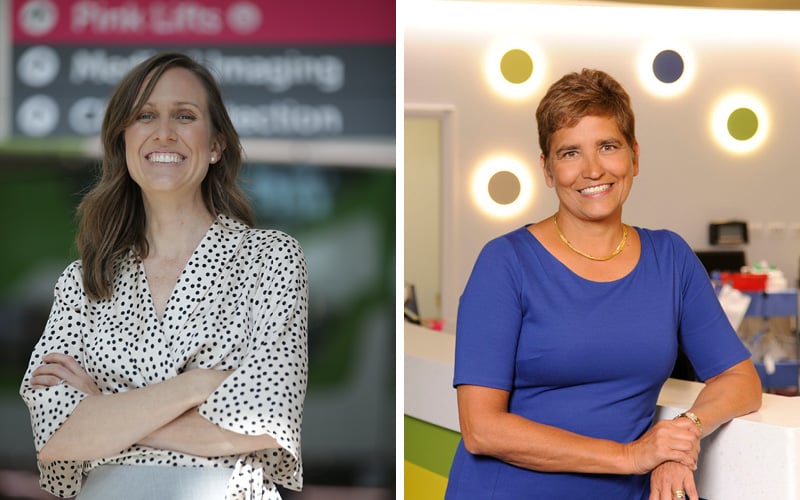
Dr Asha Bowen and Professor Desiree Silva
Much of the news about COVID-19 has focused on its impact on older people and people with underlying conditions, leaving many parents anxious and confused about what it means for pregnant women, babies and children.
Thousands of researchers around the globe are working to understand and find ways to tackle this virus as rapidly as possible. While much is still not known, the evidence emerging from studies in China and elsewhere is starting to give us a better picture about the impact on these groups.
Associate Professor Asha Bowen, paediatric infectious diseases specialist at The Kids Research Institute Australia and Perth Children’s Hospital, says it is clear from studies published so far that of all age groups, children and teens are at the lowest risk of dying from COVID-19.
Those who are infected are experiencing mostly mild to moderate disease.
“Usually with respiratory viruses children tend to become more unwell than adults, and are responsible for transmitting more illness – however this doesn’t appear to be the case with COVID-19,” Dr Bowen says.
“We are seeing lower numbers of children infected compared to what we'd normally see with other respiratory viruses.
“We don’t really know yet whether that’s because they’re not being infected, whether they’re so mildly affected that you can’t tell they have the virus, or whether it’s because they’re not being tested as they don’t meet the criteria.
"Only once blood tests are available that can document evidence of a previous infection, will we be able to determine just how many children are in this group."
Dr Bowen says that while studies so far indicate that those children who are confirmed to have the virus seem to have a much lower risk of serious illness or death than other age groups, some studies have shown that a small number of children – usually children with other health conditions – have been severely affected.
“One Chinese study of more than 2,000 children with confirmed or suspected coronavirus found more than 90 per cent of patients in the study were asymptomatic or had mild or moderate cases of the virus,” she says. “A small percentage had severe or critical symptoms, such as low oxygen levels or respiratory failure.”
“Even so, we’re not seeing much evidence around coronavirus yet to suggest that the risk to babies and young children is high. We’ll understand more as more studies emerge.”
Pregnant women
Professor Desiree Silva – paediatrician and Co-Director of the ORIGINS Project – says pregnant women are seen as a vulnerable group due to immune system changes during pregnancy which can put them at higher than average risk from infections, especially respiratory infections such as influenza.
However, she says experts have seen nothing as yet to suggest pregnant women are at greater risk from coronavirus than other adults.
“We are still in the very early days of the pandemic so we don’t have all the answers yet, but we are working to learn more as quickly as we can,” Professor Silva says.
“The most up-to-date advice from the Royal Australian and New Zealand College of Obstetricians and Gynaecologists (RANZCOG) is that, so far, we are not seeing that pregnant women are experiencing coronavirus any more severely than other members of the population.
“The evidence around coronavirus and miscarriage is so far very limited, but we don’t currently believe there is a heightened risk of miscarriage for pregnant women affected by coronavirus. Although there have been some reports of newborn children testing positive for coronavirus, RANZCOG advises it has seen no evidence to suggest the virus can pass from pregnant mother to her unborn baby.”
Professor Silva says most newborn babies don’t appear to be at greater risk of complications, and it’s not believed the virus passes from mother to child through breastmilk.
“Despite all this, we are right to be cautious and to recognise that pregnant women are a vulnerable group, and would advise pregnant women to stay at home and avoid public spaces as much as possible,” she says.
She says pregnant women and their practitioners are encouraged to proactively reduce the risk of exposure to COVID-19 through measures such as frequent handwashing, staying away from anyone who is coughing and sneezing, reducing or postponing antenatal visits, using telehealth consultations instead of face-to-face consultations, cancelling face-to-face antenatal classes, and limiting visitors while in hospital.
“We are particularly concerned to protect pregnant healthcare workers with direct patient contact, as well as other service providers in high-contact professions, who may be at higher risk of exposure due to the nature of their work,” Professor Silva adds.
“Where possible, we’d like to see pregnant healthcare workers allocated to duties that reduce their risk of exposure to those patients with, or who are suspected to have, COVID-19.
“Ideally employers will recognise the extra anxiety any pregnant worker may be feeling, and consider allowing them to be reallocated to lower risk duties, work from home, or take leave.”
For more information and the latest advice around children, babies and pregnant women and COVID-19, visit RANZCOG’s website.
